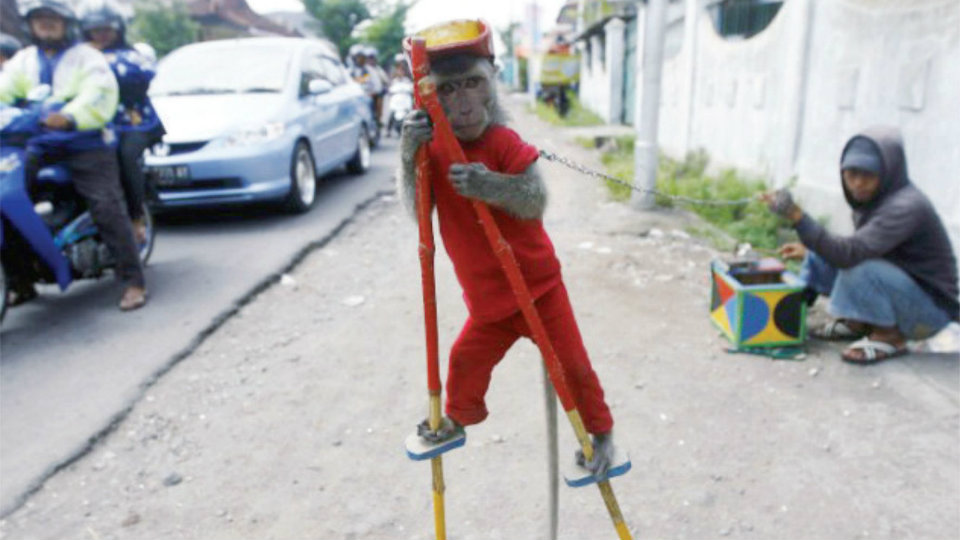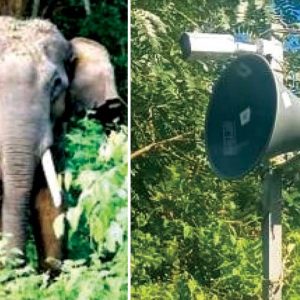In this week’s Pet Talk, Maneka speaks about monkeys dancing on the street and diet for peacocks and camels.
By Maneka Gandhi
Is it legal to have monkeys dancing on the street?
Monkeys are trained to “dance” through beatings and food deprivation. Their teeth are pulled out by the madaris so that the animals cannot defend themselves.
The Government of India has prohibited the use of bears, monkeys, tigers, panthers and lions for street performances. All species of monkey are protected under the Wildlife Protection Act of 1972. This act declares that all Indian wildlife is Government property and prohibits the capture and possession of monkeys.
Under Section 2(b), of the Performing Animals Rules, 1973, Performing Animals means any animal which is used for the purpose of any entertainment to which the public is admitted through the sale of tickets.
Section 22 of The Prevention of Cruelty to Animals Act 1960 restricts the exhibition and training of performing animals, unless the person interested in exhibiting and training the animal is registered in accordance with provisions of the Act. No animal can be exhibited or trained, where the Central Government, by notification in the Official Gazette, has restricted the exhibition and training of such animal. These following animals can’t be exhibited or trained:
1) Bears 2) Monkeys 3) Tigers
4) Panthers 5) Lions
What can one feed peacocks?
Peacocks will eat almost anything, though some foods are better for them than others. For instance, keep your trash covered, because peacocks will rummage through it in search of tasty scraps. In the wild, peacocks live on seeds, insects, berries and other nutritious items that can be readily found. In captivity, peacocks are generally fed a more controlled diet, but it consists of items similar to what is found in their natural habitat.
Insect – One the favourite foods of peafowl is insects. Peacocks are not picky and will readily consume ants, flying insects, grubs or almost any other bug. Their diet also includes spiders, which are not insects but are often grouped in the same category. Similarly, peacocks will scratch the soil in search of worms and other small creatures that may be easily uncovered.
Amphibians and Reptiles – Lizards and frogs are high in protein and will be gobbled up by most birds, including peacocks. Snails and slugs are a favourite meal as well, and they have led many people to believe that peacocks eat flowers. The truth is that they will tear apart flowers in search of snails and insects, and any flower parts that are ingested are eaten as a matter of course while trying to find the creatures that live among them.
Grain and vegetables – Corn, wheat and other grains are a common food source for peacocks. They will also eat beans and peas, and they may tear tomatoes, bell peppers or fruits apart to get to the seeds inside. Cantaloupe and watermelon, for instance, have large seeds that contain nutrients necessary to a peacock’s diet. They will not usually eat the pulp of fruits and vegetables, even though it may appear they are doing so in their search for seeds.
Berries – Peacocks not only enjoy eating fresh berries, they also love the insects that congregate around small ripe fruits.
Pet Food – In captivity, peafowl are often fed a supplemental diet of pet food or livestock feed. In the case of livestock feed, they are merely eating concentrated grains, while pet foods, such as dry cat food or dog food, contain additional minerals and nutrients that may not be readily available through ordinary scavenging. These foods are not recommended as the only diet for peacocks, but they are generally used in conjunction with fresh or dried fruits, vegetables and grains.
The vet has asked me to bathe my dog with Benzoyl Peroxide Shampoo as a treatment for mange. How should I do it?
This is the treatment recommended when your dog has been attacked by mange mites.
Demodex burrow deep in your dog’s follicles and pores, trapping yeast and bacteria, fostering secondary infection, increasing inflammation.
Benzoyl Peroxide Shampoo is considered to be the mange shampoo because of its unique ability to flush the follicles. Nothing else does the same trick. The more frequently you use it the faster you chip away the built up debris that makes life easy for the mites. But it’s not enough to just lather the dog up, let the shampoo sit there for 10 minutes then give a quick rinse.
Bathe indoors to keep the dog warm throughout this process. To keep the air in the room warm, use a small space heater if you have to. Use the warmest water possible. Bathing where it’s cold, or with cold water, is counter-productive! Benzoyl peroxide opens the pores and follicles, but cold closes them. Nothing is going to penetrate tense skin with pores and follicles that have slammed shut. Also, water is what flushes out the gunk and helps get rid of higher level mites.
Wet the dog thoroughly first with warm water (not cool or room-temperature).
Generously apply a good quality benzoyl peroxide shampoo that is formulated for pets. Cover every part of the dog’s body. Leave no safe places for mites, yeast and infection. (Diluting it slightly in a bit of warm water may make it easier to spread)
Lather well and continue to work the lather constantly for a long time. (At least 10 minutes if you can.) Keep adding a little warm water if necessary — just lather for as long as you can. Massage the skin with your fingers if possible to help break up crud build-up. Work the shampoo around the eyes, ears and paws. After some warm soaking, it can be helpful to gather folds of skin, gently gripping as close to the body as possible without causing discomfort. You want to have a decent fold of skin above your hands. Gripping both sides of the skin fold close to the body, gently squeeze as you glide your hands towards you. Massage therapists use a similar technique to help loosen toxins in tissue.
Rinse, rinse, rinse. Really flood that skin ever so thoroughly with warm running water — then rinse some more. It’s the rinsing that is your friend. Thorough, aggressive rinsing provides the flushing action we want. The goal is to open pathways so it can penetrate better, create a healthier skin environment, reduce yeast. Proper use of benzoyl peroxide shampoo does that and it helps purge toxins, waste, sebum, trash and mites lurking below the surface. If you don’t already have a hand-held shower head that sprays, get one of those hand held sprayer attachments that goes over the tap so you can rinse with copious amounts of running warm water.
Dogs with mange always need to be brushed daily. Dogs end up with dander, yeast flakes and other debris that must be removed daily. Otherwise they add to the mites’ food supply and harbour pathogens that increase the chance of secondary infection. A good habit is to brush right before performing your daily povidone iodine wipe down. It is unrealistic to expect a complete cure just by shampooing. In truth, Demodectic mange can’t be effectively cured by using just one method of treatment. This explains why chemicals and single-step treatments is such an abysmal long term recurrence rate.
What food does a Camel eat?
When we get camels into our shelter we feed them something called Laungpatti. Since camels are herbivores, they can eat almost every variety of food. Grasses, grains such as wheat and oats, husk, dried leaves and different types of seeds. Due to their large lips and large tongue, they can eat dry and thorny vegetation. They can drink salty water and consume food with high salt content. In zoos, the animals eat hay and dry grains — about 3.5 kilograms, of each, every day. Camels are grazers able to consume both soft vegetable matter, such as leaves, and hard woody twigs. Farmed camels are fed dates, wheat, grass and oats. Camels can eat shrubs as high as 3.5 meters above the ground. In summer, however, camels will regularly drink water, especially at dawn. When the water is not enough they begin to search for waterholes — a dehydrated camel can drink as much as 200 litres of water in just three minutes.








Recent Comments